History (1992): Philips DCC and Sony’s Mini Disk and Scoopman
Future storage media for computers?
By Jean Jacques Maleval | July 9, 2020 at 2:18 pmPhilips is going to launch, as of next month, its new Digital Compact Cassette and Sony, for Christmas, its Mini Disc to record sounds on a small magneto-optical disk.
Will their specs permit these reasonable consumer products to be used to store computer data?
Already available in Japan, another device from Sony, the Scoopman, should be noticed for storage since it can actually hold 120mn of digital recording on a cassette the size of a stamp!
When you look closer, few magnetic or optical supports developed for the consumer market were used to store data on computers. The first microcomputers employed audio cassettes to store data and programs but they were quickly replaced by diskettes and HDDs, both specific for data processing. Even for backups, these cassettes were not very successful, the last actor, the Japanese Teac, only took a small part of the market and now seems to prefer other types of media, especially the QIC DC-2000 cartridge.
The analog videodisk never became a leading consumer product. Only JVC succeeded somewhere with its LaserVision mostly to play movies. The videodisk technology has nevertheless helped develop 12-inch optical digital WORM disks and afterwards rewritable 5.25- and 3.5-inch ones.
Honeywell Test Instrument (Denver, CO), that became Metrum Information Storage, tried to convert VCR VHS videocassettes into media for computers. But once more with no great results. Their capacity is very high; up to 14.5B per cassette, but the media and the drive are too big and average access time to one place of the tape is slow, 45s.
Digital audiotapes are different. The 4mm DAT could have become the ideal digital audio recording support by replacing analog cassettes. But except for a few audiobugs, it remained in the professional audio segment. Consumers turned their nose up at a recording device, too expensive, and that also had to fight with musical editors on copyrights. With the rhythm of actual sales, and consequently of production, it doesn’t look like we are going towards a strong price reduction of the basic mechanism, almost the same used for backups on computers.
On another side, the 8mm helical tape was developed by Sony for video recording, and intelligently adapted for data processing by Exabyte.
Compact disks are different since they primarily are a pre-recorded digital audio support. Their large success is undeniable and they have overshadowed vinyl records. Audio CDs were recuperated and became CD-ROMs that now take a large part in data or image editing on account of their high capacity, and their low price even if their performances are low in terms of access time and transfer rate.
Finally, adapting a consumer media to a computer media is not that easy because price and especially performance restraints are too different. We should nevertheless keep an eye on these new supports offered to mass consumers as their technology enhancements can effect data processing.
This is why we will focus on 3 new systems already launched, or soon to be, by huge electronic companies, all three for digital recording (even if it is only for sounds for the time being) which should facilitate their changeover for computer applications.
The first system is based on a disk, the two other ones on magnetic tapes, one using longitudinal recording, the other helical.
We could have just as well mentioned Sony’s new Data Discman, based on an 8mm CD-ROM, another optical disk diameter, but with a technology that has no big interest since it’s just a smaller CD-ROM.
Sony’s Mini Disk Based on 2.5-inch MO platter
The first 2.5-inch or 64mm magneto-optical disk unit, about the size of a soda can top, was shown at Comdex/Fall’91 by JVC. The prototype displayed, that we never heard about since, could store 42.8MB. This concept was taken over by Sony for mass consumers with its Mini Disk (MD), with the same diameter, but only for digital audio recording for the moment. The product should be available next Christmas for $620.
The primary idea was to develop a drive similar to a CD player, but smaller and especially capable of recording digital sounds. The unit can playback and record close to 74mn of digital sounds. The disk is inserted in a cartridge just like those used for 3.5-inch floppy disks and weighs .6oz (17grams).
Actually, this drive can support two types of disks. The first ones are prerecorded optical disks similar to actual audio CDs, but smaller.
According to Sony, prerecorded disks can be made using existing CD facilities (at the difference that a CD measures 4.7 inches or 12 cm). This play-only media is a physical subset of the Sony-Philips compact disk and CD-ROM standard, using the same frame rate (1,175th of a second), error correction and 16-bit linear data recording.
For recordable MO disks, the Japanese firm has developed a magnetic layer of terbium ferrite cobalt that changes polarity with a coercive force of 80oersteds.
These small disks will be manufactured in the US by Digital Audio Disc Corp., a subsidiary of Sony in Indiana.
The system has two major advantages:
1/ it uses a single laser and
2/ direct overwrite (and not a writing mode in 2 or 3 paths as with actual MO drives).
The head can perform polarity reversals at about 100ns per reversal. The MD system uses a newly-developed data-compression technology called ATRAC (Adaptive TRansform Acoustic Coding) which compresses five times. Consequently, the audio quality is not quite as good as with ordinary CDs.
The system also includes a “shock-proof memory” which prevents sound-skipping, annoying on CDs, by storing as much as 3s in a 1Mb DRAM memory chip at a high speed (1.4Mb/s). The chip releases the data more slowly, at 3Mb/s.
The SCMS (Serial Copy Management System) process should also be incorporated to prevent musical copying.
Sony has not yet announced an eventual use of this device in data processing, but it would be surprising if this company, already involved in different computer segments, had not thought of it.
In terms of megabytes, the maximum capacity of the disk was not given but it ought to reach 120 to 150MB. This would result in a new small size storage media with a dual function (erasable and read-only), that could invade the market of CD-ROMs, MO drives and 3.5-inch floppy disks, and even smaller backup units on magnetic tapes with the possibility to directly access data.
Philips’s DCC: Digital audio cassette based on longitudinal recording
Philips NV (Eindhoven, The Netherlands), Europe’s biggest consumer electronics group, is making a big bet by launching its DCC (Digital Compact Cassette). All depends on if the DCC, as well as the DVI, works or not. Things look just as unsafe for Philips as, for instance, Kodak and its CD Photo that will also be offered in September.
The Dutch giant hopes to reiterate what it had done with its analog cassette developed and launched in 1962, and that still brings royalties for each tape sold, and would like to do just as well as with the compact disk co-developed with Sony in 1982.
Philips Consumer Electronics demonstrated its new DCC for the first time at the beginning of 1991 at the Consumer Electronic Show in Las Vegas, NE. The product should have been launched in Paris in 1992 at the opening of Eurodysneyland. But in January 92, Philips postponed the announcement until September 1992, which made this product loose some of its advance in front of its competitor Sony and its Mini Disk.
It is anticipated that by the time, there will be approximately 500 prerecorded titles available from the software industry.
The drive should be sold for $800 by Philips and $1,000 by Matsushita Electric Industrial that will join forces with Philips to launch DCC equipment. And Matsushita is the world’s biggest consumer electronics company, it includes National, Panasonic, JVC, Quasar and Technics.
Finally, the biggest advantages of the DCC system are:
– a good quality of the recorded sound, not far from the quality on CDs,
– the ability for the drive to playback old analog cassettes.
The DCC is based on a cassette, the same size as a standard analog audio one, but slimmer, and with a metal protection slider just like on diskettes. The recording of digital sounds can last 45mn (cassette D90) or 60mn (D120) per side, with autoreverse features on account of a rotative head. The tracks are longitudinal in the same direction as the chromium dioxide tape path. This tape is similar to the kind used in videotapes but measures 3.78mm wide. The tape speed is 4.75cm/s. One of the DCC technology’s keypoints is its R/W head.
Some sources believe the delay is precisely caused by difficulties of mass-producing these thin-film recording heads developed together with Seagate. Both companies will manufacture them and Seagate officially revealed this year future shipments of MR heads to Philips. On the other side, we’ve hearded that Matsushita’s first gen of DCC decks will incorporate heads manufactured by Seagate and OEMed to Matsushita from Philips in Holland. But next year, second sourcing of DCC heads could be available from TDK and Sharp, along with Matsushita’s own heads.
DCC requires a new thin-film head design, in which 3 sets of elements are combined:
– one set of nine Integrated Recording Heads (IRH) for digital recording, –
one set of nine Magneto-Resistive Heads (MAH) for digital playback,
– and finally one set of two MRH’s for analogue
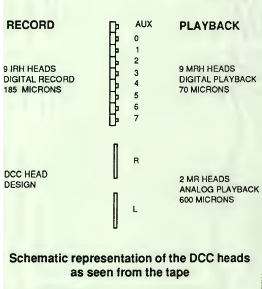
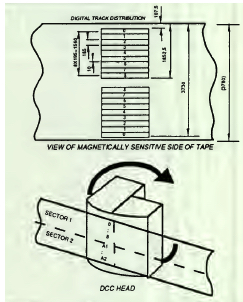
The digital heads are located on one half of the head surface, the analog heads in the other half. The digital signals are recorded on 9 parallel tracks, each 185 microns wide, with a track pitch of 195 microns. On these 9 tracks, one of them is reserved for data like the summary or the SCMS protection code to avoid more than one copy of an original. The height of the playback heads is 70 microns. DCC uses error correction system C1 and C2 Reed-Solomon product code and a special coding named PASC (Precision Adaptive Sub-band Control) based on 2 main ideas to compress sound:
1/ The ear only hears sounds above a certain level called the threshold of hearing, which depends on the frequency of the sound and on the individual. This means that it is only necessary to register sounds above this threshold.
2/ Louder sounds hide or mask softer sounds in their vicinity. With computer techniques, only the sounds above the dynamic threshold need to be registered.
Therefore, the PASC needs less than one quarter of the bit rate of compact disks, which means that the specific quality of the sound is not as good as with a CD. Philips announces a dynamic over 105dB, with a tape scrolling from 5 to 22,000Hz and a sampling frequency of 48, 44.1 or 32kHz.
The Dutch company gives no information on the capacity of its support for data processing. But it’s simple to figure out that, if the audio bit rate is 384Kb/s (which means 2.4Mb/mn), according to Philips’ announcement, it means 337.5MB on a 120mn tape, which is quite comfortable.
But is Philips still interested in data processing? The company has kept its LMS subsidiary but has stayed away from computers ever since it sold its minicomputer division to Digital Equipment on July 23, 1991.
This doesn’t mean that another company will not recuperate the DCC license to use it for storage. But even more than the Mini Disk, the biggest looser, if the digital DCC becomes successful, will probably be Sony’s 4mm DAT, more expensive, but that will have no more chances of being favored by consumers.
In this competition between DCCs and Mini Disks, launched 3 months apart, we can suppose that disks, on account of their direct access, are more likely to succeed than the magnetic tapes. But Sony is launching a very new format with a small amount of partners, when Philips is offering a complementarity with analog cassettes that count an enormous population and joined the huge Matsushita, Sony’s external competitor.
For these large consumer products, the technologic advantage is less crucial than their marketing force. Everyone remembers that Matsushita had imposed a video VHS process throughout the world when Sony’s Betamax was obviously offering better quality. To avoid a defeat, Sony, on one side, acquired a DCC license from Philips and promises to sell DCC cassettes, and, on the other side, in October 1991 it was announced that the two competitors will jointly provide licenses for Sony’s Mini Disk recording system.
Sony’s Scoopman: a digital helical scan cassette the size of a stamp
The third and last new system, still for mass consumers, needs a special attention from storage people, it comes once more from Sony and is named the Scoopman NT-1 Digital Micro Recorder. The most amazing part of it is the size of the cassette, tiny, just like a stamp, 3cm long, 2.1cm wide and 0.5cm thick and weighs 2.3grams (.8oz). It’s so small that to avoid loosing it, the Japanese company sells it in a hard plastic case 5x bigger.
The name Scoopman actually comes from the fact that the pocketsize unit is mostly made to record voices. It’s an exceptional tool for a reporter that, without any settings, is sure to have a digital recording with an exceptional quality. We often use this Scoopman for interviews: even if there are background noises, several people talking at the same time, or if the microphone is close or not to the recording source, there is no problem when decoding the tape.
The big advantages of the Scoopman, actually sold for ¥99,800 in Japan in its international version, are the quality of the voice recording, the small size of the cassettes, but also the low power consumption that allows 7 hours of recording with a small 1.5-volt R6 battery (size AA).
On the contrary, frequency response, from 10 to 14,500 Hz, gives a quality of musical recording inferior than with compact disks as we experienced it.
Actually there are 2 sorts of cassettes: the NTC-90 (two times 45mn) for ¥1,223 and the NTC-60 (two times 30mn) for ¥962 in Japan.
An NTC-120 with two times 60mn in the same volume is announced for Fall 92.
Inside there is a 2.5mm tape with a 6.35mm/s speed. It is pressed by a drum spinning at 3,000rpm with 3 recording heads and 9.8micron wide tracks that are written at an angle of about 4.4°.
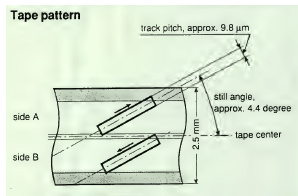
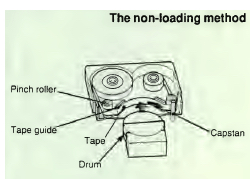
A keypoint of Sony’s Non-Tracking format (NT) is that, with the conventional helical scan (DAT or VHS), it is necessary to have a loading mechanism that drew out the tape from the cassette and wrapped it around the external rotary drum. Here, the drum enters in the cassette, is just pressed vs. the tape guides, and the tape wraps around the drum automatically. Additionally, the rotary heads are not required to precisely trace the recorded tracks during playback. Instead of tracing track accurately, the rotary heads turn at a higher speed (twice as fast as that for recording) and reads more data.
The data picked may be disconnected or fragmented; however, the IC memory rearranges and augments the data and faithfully reproduces the original sounds.
Therefore, the number of mechanical parts are reduced. The specs given with the unit don’t give an idea of the amount of binary data that could be stored in this Scoopman that doesn’t seem to use any data compression system but just a cross interleaving code for error correction. But, according to an engineer from Sony, France, the tape is able to store as much as 690MB. We can dream of a version of the Scoopman that could easily be integrated into a notebook computer to automatically backup data from the secondary memory, a HDD or a flash card, on this tiny removable cassette.
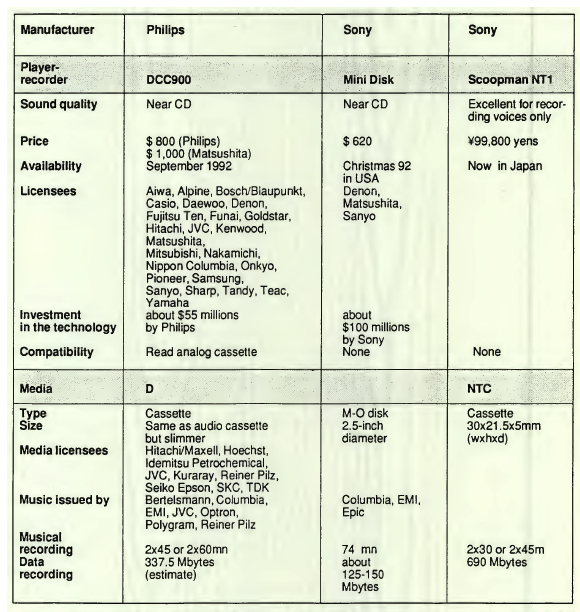
This article is an abstract of news published on the former paper version of Computer Data Storage Newsletter on issue ≠55, published on August 1992.












 Subscribe to our free daily newsletter
Subscribe to our free daily newsletter
